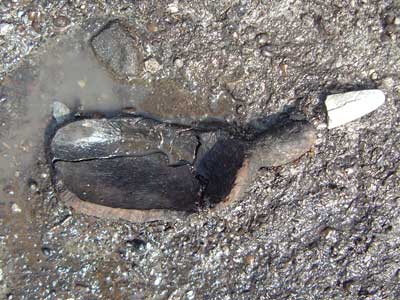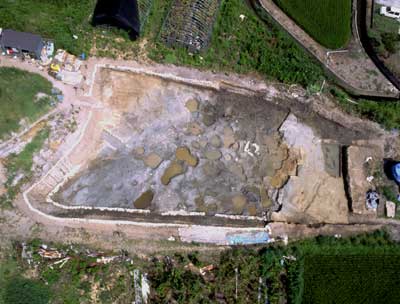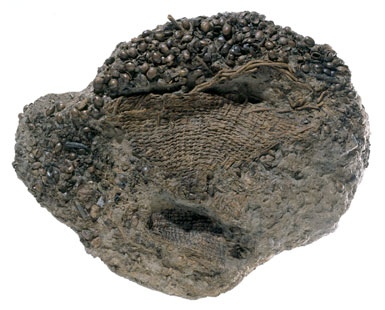Shōfukuji:
Large quantities of acorns and woven basketry unearthed from a waterside site. A rare straight-shafted stone axe is a precious item showing even the method of use.
|
|
|

|


|

Woven basket Straight-shafted axe
Ladle-shaped wooden utensil in situ (from the south)
|
Shōfukuji Site, Kurume City, Fukuoka Prefecture
Shōfukuji is located near the center of Kurume City, at the end of a ridge extending from Tobitake mountain. The current excavation ascertained a stream-like topography, with an abundant source of water, at which earthen pits were dug. This stream was from the first half of the Late Jōmon (about 4,000 years before the present), and large volumes of nuts consisting mostly of acorns were recovered from the pits, along with woven basketry, vessels, a shafted stone axe, and ornamental beads.
Pits for storing acorns
The more than sixty pits, dug near a point in the stream where water gushed forth, apparently had different uses, dividing into the following three main types: (1) those for storing acorns, (2) those for immersing wood and utensils, and (3) those with basketry lining the entire pit bottom. Storage pits for acorns are the most numerous among these, yielding from several thousand to several tens of thousand acorns apiece.
A straight-shafted axe, large numbers of acorns, and basketry are unearthed
Pottery, stone tools, wooden utensils, basketry, nuts, leaves and so forth were recovered from within the pits. Among these were more than one hundred baskets woven with vine, valuable materials for conveying methods of basket-weaving from the Jōmon period to the present day. Acorns, a valuable foodstuff, were unearthed in large amounts. The majority were from a Japanese yew whose acorns have little harshness, but among them were very harsh acorns of oaks and other species gathered together in a single location, from which we can infer that the Jōmon people were storing acorns according to their variety.
In addition, the straight-shafted axe is the only one from the Jōmon period to be found with the blade in its hafted position, and its methods of hafting and use are receiving attention. (Kumashiro Masayuki)


